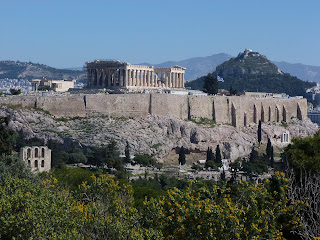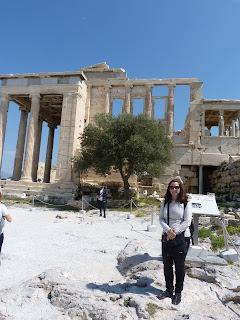After a good nights sleep and a bit of a sleep in, we felt refreshed and ready to explore the many historical sites around Athens, on this gloriously sunny Sunday. Our accommodation in Plaka had us within walking distance of most of the key archeological sites and other things we wanted to do, so we headed for the most significant one first, namely the Acropolis. The most striking and iconic landmark in Athens.
Tickets were required, and a bit of queue, but soon we began to ascend the sacred rock. There are numerous remnant structures across the site and, not being well versed in Ancient Greek, the significance of each was not easily understood by us, even though there was lots of information on the signage; however the overwhelming impression was of the complexity and sophistication of ancient Greeks. We stopped at the Theatre of Dionysus and the Odeon of Herod the Atticus, on the southern slopes, both locations for ancient Athens’ theatrical celebrations. Then climbed to the plateau entering through the Propylaea to see the Erechtheion, the Temple of Athena Nike and, of course, the iconic Parthenon. While quite crowded, it was still amazing to soak in the sights and reflect on the significance of this sacred site, which has been inhabited for over 4 millennia.
After descending, we then climbed the nearby Areopagus Hill to look back at the Acropolis and also take in the views of the Agia Marina and National Obsevatory. Like the plateau of the Acropolis, the rock on Areopagus Hill was worn so smooth by years of human habitation, it was quite slippery and we needed to watch our step as we took in the views.
We then headed towards the Ancient Agora, stopping for a late lunch of falafel and coffee in one of the many cafes along the Adrianou in the Monastiraki area.
The Agora is close to the Acropolis and was the major commercial area and heart of public life in Ancient Athens and the birthplaces of democracy. There was lots of remnants of this ancient marketplace but most impressive was the Temple of Hephaetus, which is probably the most well preserved of all the ancient temples in Athens, standing largely as built. The Stoa of Attalos housed a museum of many artefacts from the Agora and remants of various statues and monuments. The Agii Apostolic, also on the site was worth a quick vist. We also walked the Dromos or Panathenaic Way, the significant ancient thoroughfare through the Agora to the Acropolis - you could imagine festivals, processions and chariot and running races happening here….
Kicked out of the Agora at closing time, we wandered through the chaotic Athens Flea Market in Monastiraki and ended up in Syntagma Square. While there, we thought we would get a photo of the Hellenic Parliament building and it turned out that our timing was perfect to watch the changing of the guard at the Tomb of the Unknown Soldier; with the guardsmen in their traditional costume and choreographed marching - it was most entertaining!
The cobblestone streets of Plaka are lined with souvenir shops, watched over my surly-looking Greek women and a multitude of cafes and taverns with enthusiastic sprukers encouraging you to eat at their establishment. We were barely out the door of our hotel when Yiannis was promising us a magical meal at Estia…. while somewhat sceptical we gave in and let him whisk us in to the “best seats” in the house to enjoy Saganaki and beer, lamb casserole with feta and potatoes (no knife needed promised Yiannis) and Moussaka washed down with house red then banana and Nutella crepe and hot chocolates - quite enjoyable (if not magical)












No comments:
Post a Comment